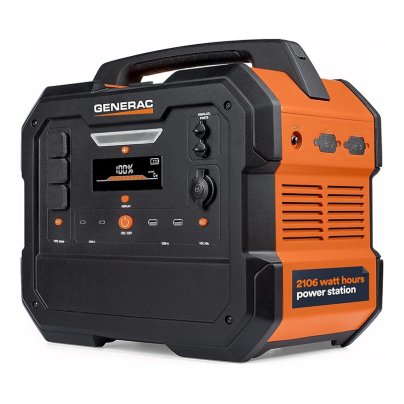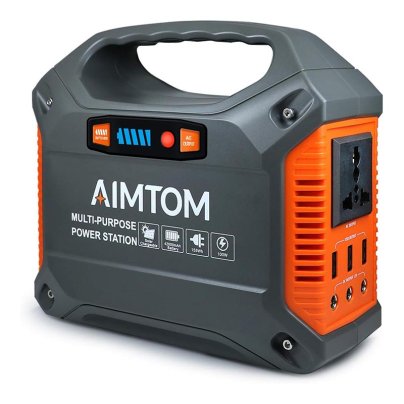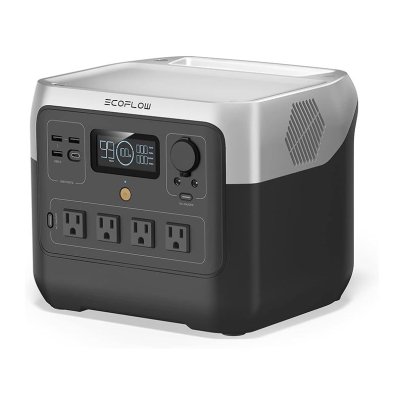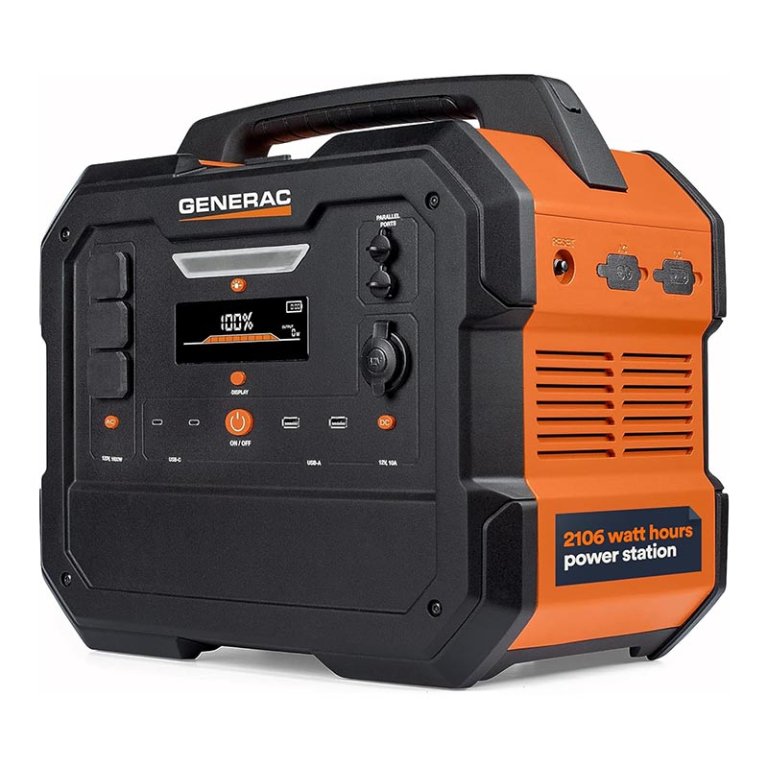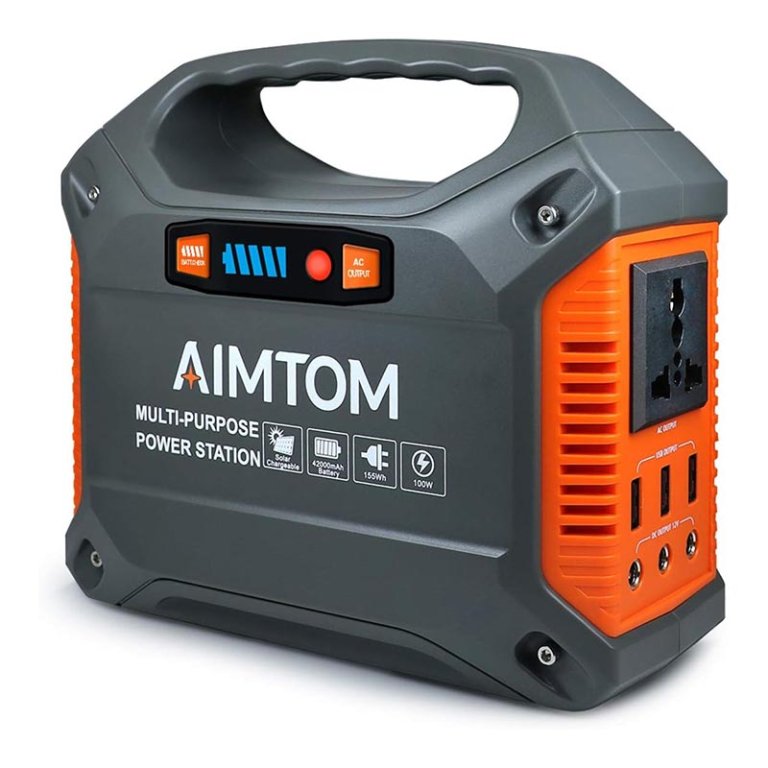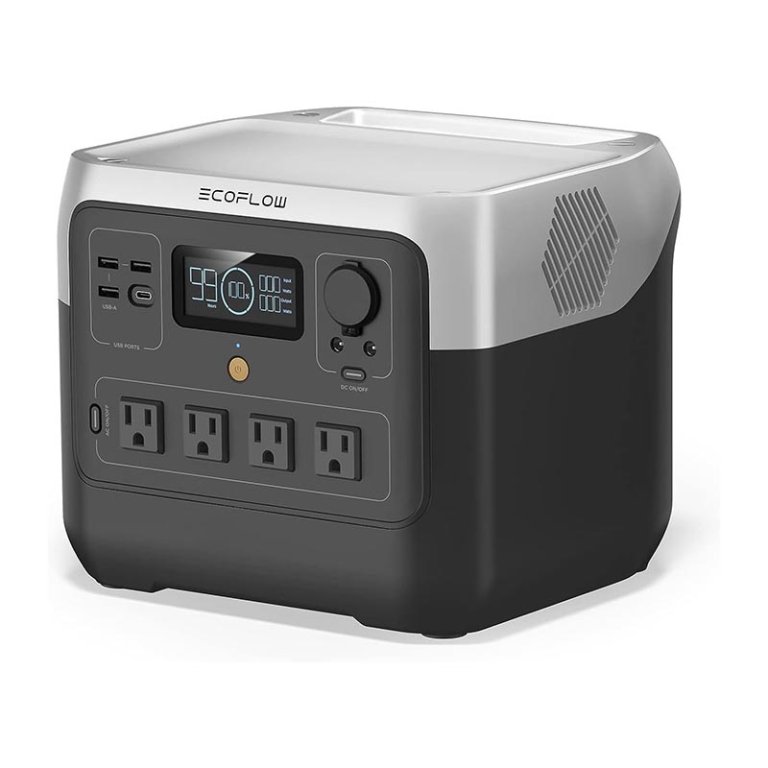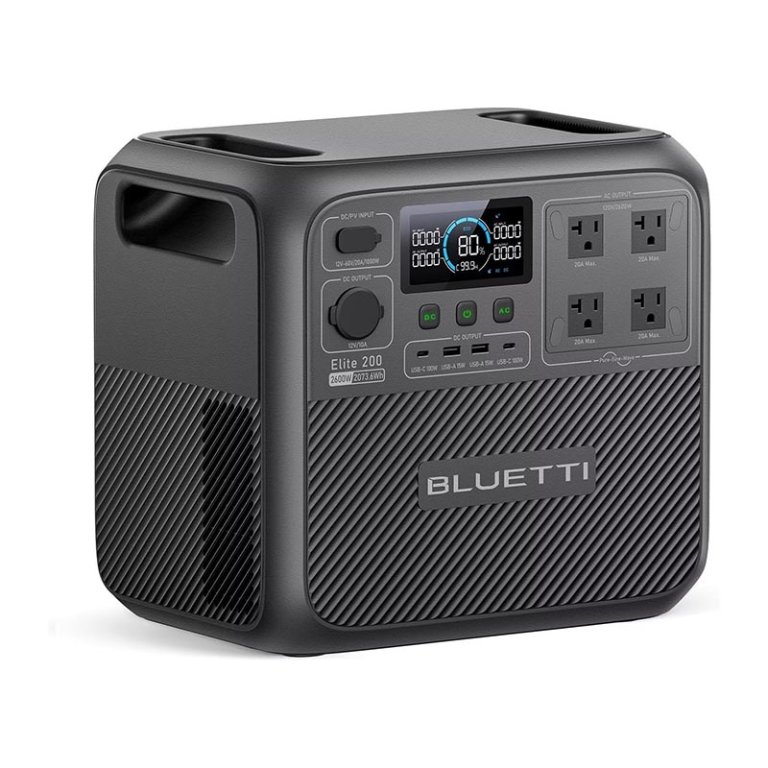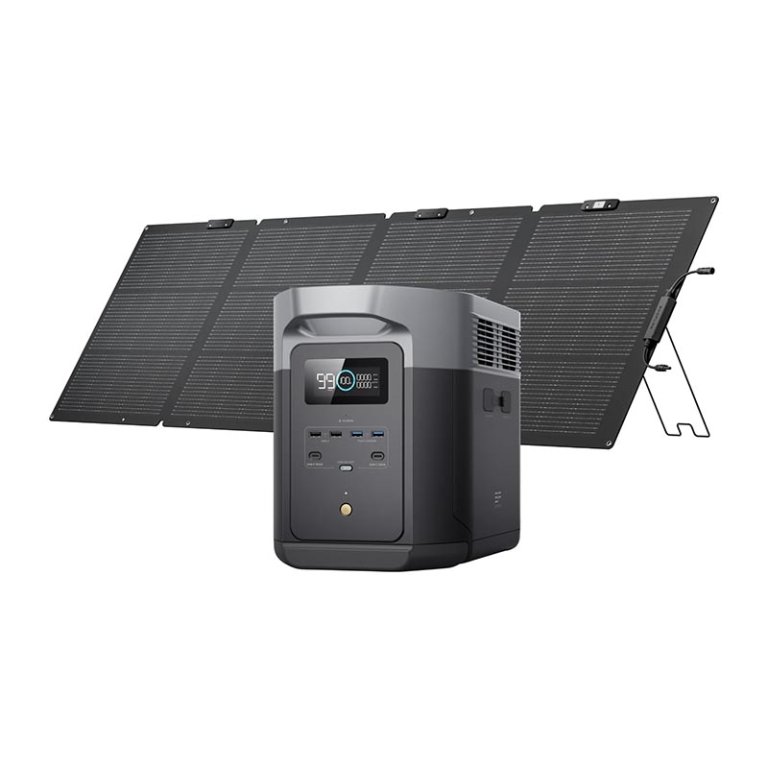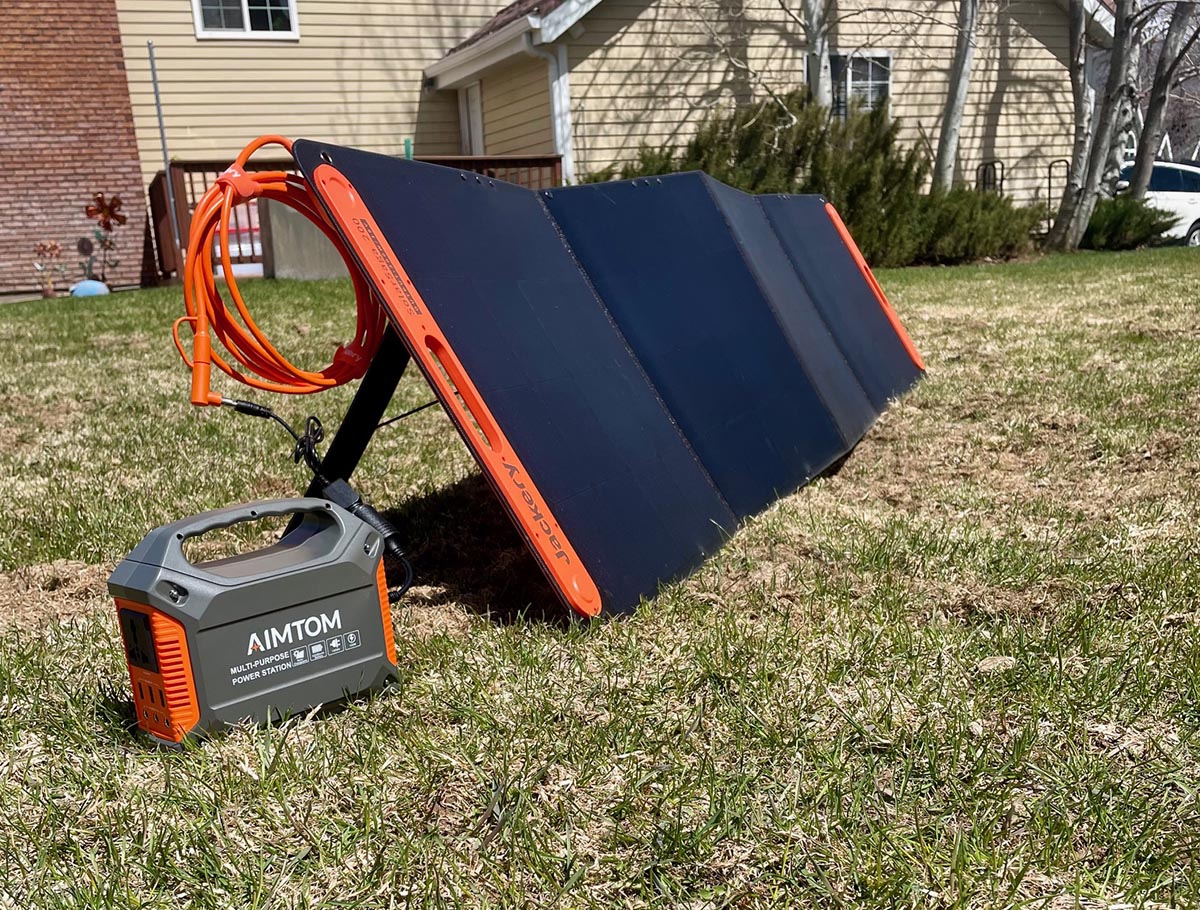

We may earn revenue from the products available on this page and participate in affiliate programs. Learn More ›
Solar generators, also known as solar power stations, are an eco-friendly way to harness energy from the sun to run electric appliances and charge digital devices. Unlike gas and propane generators, they’re safe to use indoors and virtually silent during operation.
Once considered overly expensive and underpowered, solar generators are getting more affordable and useful each year, so we put eight popular models to the test to see how well they could produce and store energy. After using them for everything from charging phones and tablets to running refrigerators and table saws, we chose the Generac GB2000 Portable Power Station as the best option for most users thanks to its impressive performance, quiet operation, and overall value.
Read on to learn more about this and the rest of the models that made our list of the best solar generators available today.
- BEST OVERALL: Generac GB2000 Portable Power Station
↓ Jump to Review - BEST BANG FOR THE BUCK: Aimtom PowerPal X 155Wh Portable Power Station
↓ Jump to Review - BEST COMPACT: EcoFlow River 2 Pro Portable Power Station
↓ Jump to Review - BEST MIDRANGE: Bluetti Elite 200 V2 Portable Power Station
↓ Jump to Review - BEST FOR OUTDOORS: EcoFlow Delta 2 Max Solar Generator
↓ Jump to Review
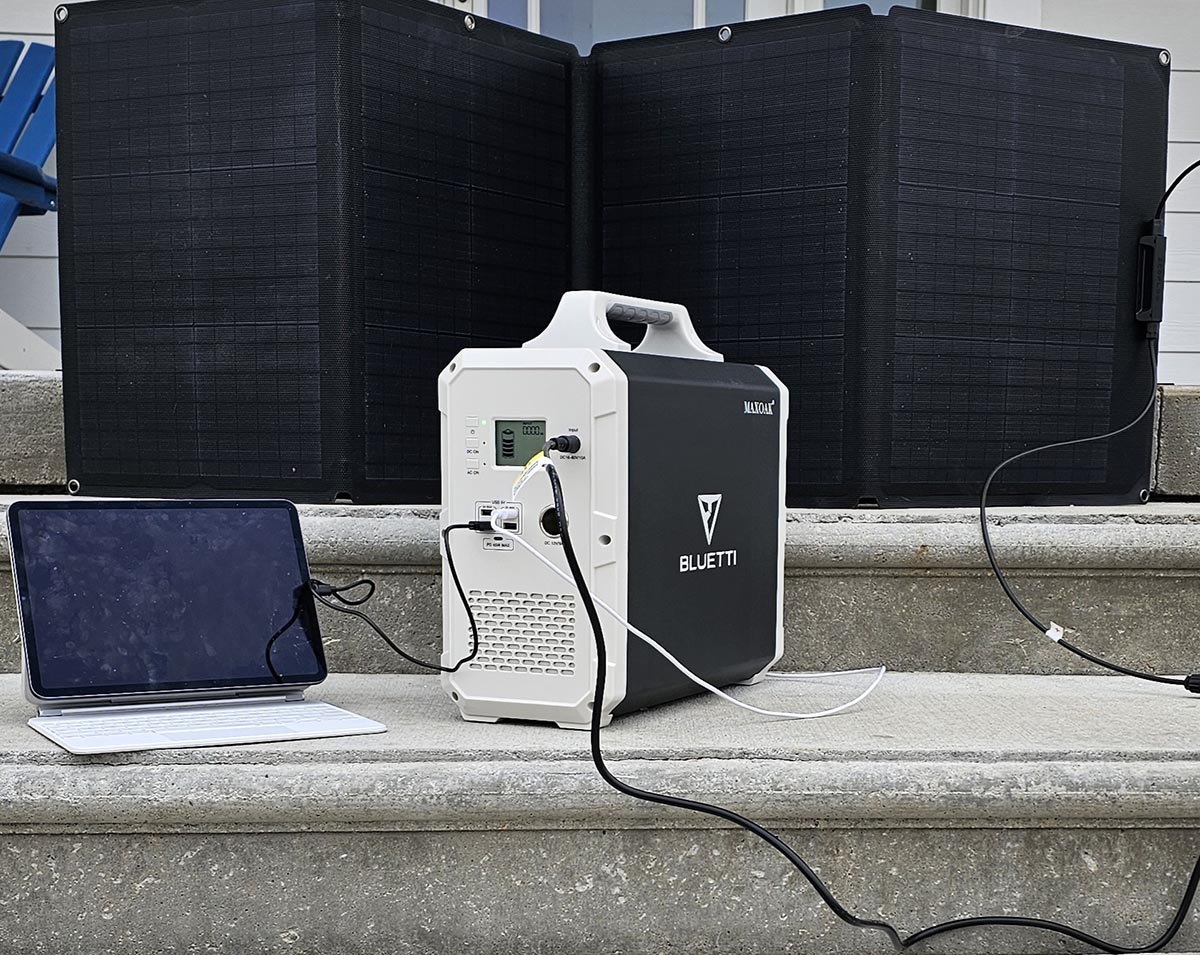
Before You Buy a Solar Generator
The portability of solar-powered generators makes them ideal for traveling, camping, and outdoor events because they are easy to pack, store, and move. The units are also a solid backup source for when emergencies occur at home due to severe weather or blackouts.
While solar generators are a clean energy source, they do have limitations because of their wattage capacity and slow recharging. A high-capacity solar backup generator can often produce enough power to keep the lights on or run televisions and electronic devices for hours. However, they don’t harness enough power to run all of the large appliances in a residence at one time or for an extended period. In general, a solar generator for house use will run only a few low-wattage appliances, so depending on your needs, something like a dual-fuel generator might be a better choice.
Solar Generators Comparison
| Product | Wattage | Watt-hours | Charging source | Outlets/ports | Weight |
|---|---|---|---|---|---|
| Generac GB2000 Portable Power Station | 3,200 peak watts and 1,600 running watts | 2,106 | Alternating current (AC) or solar | Three 120 volt (V)-13.3 amp (A) AC outlets; one 12V direct current (DC) port; 2 USB-A ports; 2 USB-C ports; wireless charging pad | 43 pounds |
| Aimtom PowerPal X 155Wh Portable Power Station | 150 peak watts and 100 running watts | 155 | AC, solar, or DC | One 110V AC outlet; three 12V DC ports; 3 USB-A ports | 3.48 pounds |
| EcoFlow River 2 Pro Portable Power Station | 1,600 peak watts and 800 running watts | 768 | AC, solar, DC, or USB-C | Four 120V AC outlets; one 12V DC port; 2 DC5521/barrel ports; 3 USB-A ports; 1 USB-C port | 18.2 pounds |
| Bluetti Elite 200 V2 Portable Power Station | 3,900 peak watts and 2,600 running watts | 2,074 | AC, solar, or DC | Four 120V AC outlets; one 12V DC port; 2 USB-A ports; 2 USB-C ports | 53.4 pounds |
| EcoFlow Delta 2 Max Solar Generator | 4,800 peak watts and 2,400 running watts | 2,048 | AC, solar, or DC | Six 120V-15A AC outlets; one 12V DC; 2 DC5521/barrel ports; 2 USB-A ports; 2 USB-A fast-charging ports; 2 USB-C ports; | 50 pounds |
Our Top Picks
While each solar generator for home use on the list below comes from a reputable generator brand, they all differ in terms of size, power, battery capacity, outlets, and special features. If you’re looking for a way to use solar energy to produce backup power, one of the following generators will fit the bill.
Best Overall
Photo: AmazonWhat We Like
- Fully charges in under 4 hours via AC
- Powerful enough for tools, appliances, and digital devices
- Designed for emergency, off-grid, or recreational use
What We Don’t Like
- Does not come with solar panels
Specs
- Wattage: 3,200 peak watts and 1,600 running watts
- Watt-hours: 2,106
- Charging source: Alternating current (AC) or solar
- Outlets/ports: Three 120 volt (V)-13.3 amp (A) AC outlets; one 12V direct current (DC) port; 2 USB-A ports; 2 USB-C ports; wireless charging pad
Our Ratings: Ease of Use 5/5; Noise 5/5; Portability 3.5/5; Power 4.5/5; Value 5/5
Solar generators have come a long way in the past decade, and nowhere are the improvements more apparent than with the Generac GB2000. This solar-powered generator delivers up to 3,200 peak and 1,600 running watts via three AC ports, four USB ports, a 12-volt DC port, and a wireless charging pad. It’s a reliable choice for emergency backup power or as a solar portable generator for tailgating and camping.
The Generac battery generator for home use doesn’t come with solar panels, but we charged it using our own EcoFlow 400-watt portable panels. With the EcoFlows, it went from 28 percent to 100 percent in just under 5 hours, though charging time will vary based on panel capacity and weather conditions. Once charged, we used it to power several household appliances, including a fridge and lamps, multiple electronic devices, and even a miter saw. Also, since it only expends as much power as you use, it’s more energy efficient than fuel-powered models that generate a set amount of wattage whether you’re using the power or not.
As impressed as we were by this model, it’s a tad heavy at 43 pounds. That weight does make it challenging to carry for a long time, but the sturdy nonslip handle helps quite a bit during short moves.
Read our full review: Generac GB2000 Portable Power Station
What our tester says: “This generator couldn’t be simpler to use. And based on my love of camping and previous experience spending the night in a snowbank during an eastern Colorado snowstorm, it’s totally worth the cost.”—Glenda Taylor, Product Reviews tester and writer
Get the Generac solar generator at Amazon, The Home Depot, or Walmart.
Best Bang for the Buck
Aimtom PowerPal X 155Wh Portable Power Station
Buy at AmazonWhat We Like
- Lightweight and compact for powering small electronics
- Charges via solar, wall outlet, or DC port
- Built-in emergency solid-state and blinking flashlight
What We Don’t Like
- Aimtom’s compatible solar panels unavailable in the U.S.
- Power output is limited to small appliances
Specs
- Wattage: 150 peak watts and 100 running watts
- Watt-hours: 155
- Charging source: AC, solar, or DC
- Outlets/ports: One 110V AC outlet; three 12V DC ports; 3 USB-A ports
Our Ratings: Ease of Use 4/5; Noise 5/5; Portability 5/5; Power 3/5; Value 5/5
This small solar generator from Aimtom is lightweight, compact, and convenient. It has one AC outlet, three USB-A ports, and three 12-volt DC ports. Since its output caps at 150 peak watts and 100 running watts, it’s best for charging devices and powering small electronics or appliances like mini fridges and CPAP machines.
The Aimtom solar generator was easy to test, though limited. It was great for charging a phone, tablet, and set of wireless earbuds on a road trip (it was still at 5 bars after 6.5 hours), but we didn’t have much use for its three DC ports. The AC plug was a nice feature, though, and we were able to plug in a small handheld vacuum to charge.
In terms of input options, this lunchbox-size solar generator features the option to recharge via a wall outlet, car port, or solar panel (not included). We waited several months for Aimtom’s solar panels to come back in stock in the U.S., but they never did. We finally gave up and used a Jackery solar panel for charging. Thanks to the included adaptors, we hooked the two products together without issue, and the battery indicator went from zero to five in just 4 hours.
What our tester says: “It’s been close to 2 years since I first tested this, and our family still uses it all the time. We take it on road trips, camping, and to the beach, and with three USB-A ports and plenty of power, it’s easy for anyone we’re with to keep their phone charged.”—Michelle Larson, Product Reviews tester and writer
Get the Aimtom solar generator at Amazon.
Best Compact
Photo: AmazonWhat We Like
- About the size of a personal cooler
- Battery charges/empties 3,000+ times before losing capacity
- Features standard charging inputs plus USB-C
What We Don’t Like
- Output seemed slightly out of calibration
Specs
- Wattage: 1,600 peak watts and 800 running watts
- Watt-hours: 768
- Charging source: AC, solar, DC, or USB-C
- Outlets/ports: Four 120V AC outlets; one 12V DC port; 2 DC5521/barrel ports; 3 USB-A ports; 1 USB-C port
Our Ratings: Ease of Use 4.5/5; Noise 4/5; Portability 4.5/5; Power 4/5; Value 4.5/5
When it comes to on-the-go needs and emergency-only backup power, the EcoFlow River 2 Pro is ideal. Certified by TÜV Rheinland (Germany’s stringent vehicle inspection agency), it’s safe for vehicle use, provides up to 1,600 watts in X-Boost mode, and 800 watts of running power. It has 11 output ports, including four standard plugs, three USB-A ports, one USB-C port, one 12-volt DC port, and two DC-5521 ports. It also supports standard wall charging, solar charging, DC vehicle charging, and USB-C charging. You can connect to the River 2 Pro via Wi-Fi or Bluetooth and control the settings for customized use.
During testing, we liked that this model fit in the back of our quad-cab pickup and provided plenty of power for a family road trip, including charging a laptop and several personal devices. The only issue we ran into was that the display screen didn’t register our heater’s low and medium fan settings. We didn’t see this mentioned in any other online reviews, however, so it may have just been our unit. Plus, the problem didn’t impact the fan’s use.
Get the EcoFlow River 2 Pro portable power station at Amazon, Lowe’s, The Home Depot, Walmart, Best Buy, or EcoFlow.
Best Midrange
Photo: AmazonWhat We Like
- High-capacity LiFePO4 battery
- Charges quickly with AC, solar, or DC power
- Powerful enough for a full-size fridge
What We Don’t Like
- Quite heavy at 53 pounds
Specs
- Wattage: 3,900 peak watts and 2,600 running watts
- Watt-hours: 2,074
- Charging source: AC, solar, or DC
- Outlets/ports: Four 120V AC outlets; one 12V DC port; 2 USB-A ports; 2 USB-C ports
Our Ratings: Ease of Use 4/5; Noise 5/5; Portability 3/5; Power 4.5/5; Value 4/5
Bluetti’s new Elite 200 V2 solar generator for camping, emergency backup, and off-grid living features an upgraded high-capacity LiFePO4 (lithium iron phosphate) battery that offers 2,600 running watts and 3,900 peak watts. In our tests, it delivered enough juice to run a full-size refrigerator for over 30 hours and a portable AC for about 6 hours on high. With four AC outlets, one DC port, two USB-A ports, and 2 USB-C ports, it also had enough outputs to charge nearly every device in our test space at once.
Not only is this pick powerful right out of the box, it’s also built to stay that way long term. The advanced battery is more durable than a standard lithium-ion battery, and Bluetti promises you can charge and discharge it more than 6,000 times. Also, we found this unit very easy to use, especially via the Bluetti app, which displays device charging status, generator power use, and current battery health. Unfortunately, it is a bit hefty at over 50 pounds, making it a better solar generating station for use at home, tailgating, or car camping than carrying from place to place.
Get the Bluetti solar generator at Amazon or Bluetti.
Best for Outdoors
Photo: AmazonWhat We Like
- Charges via AC, solar, or DC for on-the-go use
- Connecting 2 extra batteries (sold separately) delivers up to 6,144 watt-hours
- Can power 15 devices at once
What We Don’t Like
- No 30-amp outlet to power an RV
Specs
- Wattage: 3,900 peak 4,800 peak watts and 2,400 running watts and 2,600 running watts
- Watt-hours: 2,048
- Charging source: AC, solar, or DC
- Outlets/ports: Six 120V-15A AC outlets; one 12V DC; 2 DC5521/barrel ports; 2 USB-A ports; 2 USB-A fast-charging ports; 2 USB-C ports
Our Ratings: Ease of Use 4.5/5; Noise 5/5; Portability 4.5/5; Power 4.5/5; Value 4.5/5
Portable power doesn’t get more convenient than the EcoFlow Delta 2 Max solar generator with panels. Rugged yet relatively lightweight, it runs on a LiFePO4 (or LFP) battery that lasts up to 3,000 cycles, which is nearly 10 years of daily use and nearly double the expected lifespan of traditional lithium-ion batteries. It charges via solar panels, a wall outlet, or a 12-volt car outlet, and it offers 15 electrical outlets to power up most home appliances and small electrical devices. While the kit we tested included a 2,400-watt power station and a 200-watt trifold solar panel with its own stand, you can purchase additional panels and extra batteries if you need more solar input or power output.
During testing, we charged the EcoFlow two ways: via a single 200-watt solar panel, which took about 12 hours, and with simultaneous solar and AC charging, which only took 43 minutes. In its fully charged state, the large digital display showed an estimated runtime of 14 hours for our full-size fridge. After 6 hours, the charge level read 40 percent, with 6 hours remaining. Then, 10 hours after starting, we ended the test with a 5 percent charge still showing on the battery life indicator. That performance proved impressive for emergency backup and more than enough to power extras like a coffee maker and string lights on a weekend trip.
Read our full review: EcoFlow Delta 2 Max Solar Generator
Get the EcoFlow solar generator at Amazon (1 solar panel), Lowe’s (solar panels sold separately), The Home Depot (solar panels sold separately), or EcoFlow (1 solar panel).
Jump to Our Top Picks
How We Tested the Best Solar Generators
| Testing Stats | |
|---|---|
| Products tested | 8 |
| Time spent testing | 20+ hours |
| Tests performed | 9 |
| Price range | $100 to $1,600 |
To put together this list, we researched more than 25 portable solar generators, paying close attention to generator type, power output, weight, ports, and other special features. We also considered quality, ease of use, and customer satisfaction before narrowing our choices to eight top-rated solar generators for testing.
We then used each model in our own homes, charging them outdoors with solar panels and noting how much energy they offered to power a range of appliances and devices. We ran them until their batteries were empty, charged them via wall outlets, and tested them again. We monitored how much sound they made during use, how easily they turned on after being left in the cold overnight, if they were portable enough to move long distances, and whether extra features like apps or carrying cases added value.
We scored each solar generator using a rubric, averaged the points to determine the best performers, and assigned awards based on standout features or functions.
| Product | Ease of Use | Noise | Portability | Power | Value |
| Generac GB2000 Portable Power Station | 5 | 5 | 3.5 | 4.5 | 5 |
| Aimtom PowerPal X 155Wh Portable Power Station | 4 | 5 | 5 | 3 | 5 |
| EcoFlow River 2 Pro Portable Power Station | 4.5 | 4 | 4.5 | 4 | 4.5 |
| Bluetti Elite 200 V2 Portable Power Station | 4 | 5 | 3 | 4.5 | 4 |
| EcoFlow Delta 2 Max Solar Generator | 4.5 | 5 | 4.5 | 4.5 | 4.5 |
What to Consider When Choosing a Solar Generator
While searching for the best solar-powered generators available for home or travel, start by considering the intended use. How and where you plan on using a solar generator will determine the size, power, and capacity of the unit you’ll need.
Purpose and User Activity
While a generator with solar panels can be useful for anyone who travels and stays in remote off-grid places, it can also serve as a reliable backup energy source in case of a natural or man-made disaster.
If the primary purpose is travel, look for solar generators that help make traveling simpler. A model with a 25-amp outlet will be compatible with RVing, while one with car-charging capabilities will be convenient for on-the-go use. Those after a solar-powered whole-house generator for emergency use will need to prioritize power and the type and number of outlets necessary for their most essential appliances.
Size and Solar Input
When choosing the right size solar generator, keep in mind battery capacity and power requirements so that you can avoid overloading it. Most solar generators can keep portable electronics, smartphones, tablets, power tools, small appliances, and cordless tools powered up for hours. However, to power larger loads like a refrigerator plus an air conditioner all day, you’ll likely need a higher-capacity solar whole-house generator.
As with a house with solar panels, solar input refers to the number and wattage of the solar panels. Since solar panels collect and convert sunlight into energy that is stored in the generator’s battery, solar input controls a generator’s operating time and how long it takes to recharge.
The solar panels used in conjunction with a portable solar generator are mobile and easy to manipulate. Unlike the panels found on residential or commercial properties, they are smaller in size and have a lower wattage capacity, which means less solar input than their larger counterparts.
Power Requirements
The output of power from a solar generator should match electrical needs. Battery power is measured in watts, which is the maximum amount of power a generator provides when it’s running. Battery capacity—referred to as watt-hours—is the total amount of stored energy.
When the generator is in operation, the watts represent the rate of power flowing from its battery to an electrical device, and the watt-hours are the maximum level of energy it can deliver. For example, a solar generator with 500 watt-hours can store a total of 500 watts when it’s fully charged. Thus, a 500-watt solar generator is only able to power electrical appliances and devices that don’t exceed 500 watts to run.
Battery Storage Capacity
The battery in a solar generator is where the energy captured from the solar panel is stored for later use. Solar generators usually have lithium-ion or lead-acid batteries. Battery storage allows users to run the generator at night or on days with limited sunlight.
The capacity of the batteries determines the duration of the generator. The more power an electronic device requires, the faster the battery charge will run out. The length of the battery charge is also based on the number of devices drawing power from the generator at the same time.
A larger battery capacity is necessary to power electrical appliances that require higher watts. Lower capacity is sufficient for lights, cell phones, and laptops. For instance, a 500-watt solar generator can power an LED light for 100 hours, while it will only power a mini fridge for about 10 hours.
Inverter Rating
Direct current and alternating current are the two forms of electricity. DC is electricity that flows only in a forward direction. AC is electricity that flows both forward and backward. The energy harnessed by solar panels is DC. A solar inverter generator converts low DC power from the batteries to AC power for usage.
The inverter rating translates to the maximum watts a solar generator can extract at any time. For example, a 1,500-watt inverter can draw up to that amount of wattage in AC power. Keep in mind that the inverter size or rating doesn’t always correlate to a solar generator’s overall firepower. Battery storage is also important.
Expandability of Power
Eventually, you may want to expand the capability of your solar generator. However, upgrading a solar generator is not always feasible.
Expanding power is based on the sustainability of the charge controller, which sends power in one direction from the solar panels to the batteries. As the integral component of the solar generator, the primary job of the charge controller is to protect the durability of the batteries.
The charge controller can only process the maximum number of watts and voltage that it’s built to manage, so you may not be able to expand beyond its charging ability. If battery capacity doesn’t support additional solar panels, power expandability is unachievable.
Types of Solar Generators
In areas with frequent power outages, a generator provides an interim source of electricity. Two types of solar generators are available for at-home use: solar backup generators and portable solar generators. Both generators provide solar power but differ in terms of wattage capacity, energy storage, and cost.
Solar Backup Generators
Solar backup generators are designed to power up when the electrical grid fails and are an efficient alternative to installing a complete system. These generators use several batteries to store energy for high-wattage output. They provide sufficient backup power to turn on lights, televisions, computers, and small to midsize appliances.
Typically, it takes less than 48 hours to charge a solar backup generator to full capacity, but the time can vary depending on the size of the solar panels and the amount of sunlight. You can keep these generators either indoors or outdoors. The disadvantage of solar backup generators is their weight, making them somewhat difficult to move. Additionally, a generator that is large enough to power an entire residence is expensive.
Portable Solar Generators
Portable solar generators are lightweight, so you can take them anywhere. They are ideal for homes, cabins, campsites, RVs, cars, and boats. Some generators are equipped with a pull handle or attached handgrip for effortless transporting. Solar panels recharge the battery in a portable solar generator.
Portable solar generators do have drawbacks. They may either have inadequate wattage capacity to power larger appliances, such as refrigerators, dishwashers, washing machines, hot water heaters, and sump pumps, or may not be capable of powering multiple devices at the same time.
If they use low-wattage solar panels, it may take a long time to recharge the generator. On the plus side, they are quiet generators that don’t emit noise or carbon dioxide, plus they’re affordable and low maintenance.
Tips for Using a Solar Generator
With a multitude of solar generators to choose from, shoppers may find it difficult to decide which one fits their requirements. To begin, they will want to pinpoint how and where they plan to use it.
Solar generators are available in a variety of sizes with various wattage and storage capacities. They are primarily for powering homes during electrical outages or for outdoor activities like camping, hunting, sailing, fishing, and traveling. Solar generators are also an ideal power source for outdoor events, such as parties, festivals, craft fairs, and farmer’s markets.
How much shoppers want to spend on a solar generator is another important consideration. As solar generators increase in size and capacity, so does the price. Keep in mind that most cheap home generators with solar power don’t include solar panels, so that extra purchase will add to the expense.
- The solar generator should match shoppers’ intended purpose.
- It’s important to select the appropriate size, wattage, and storage capacity for usage.
- Focus on the features that suit an individual’s plans for the generator, such as the number of plug-in ports, charging speed, portability, carrying handle, expandability, and weight.
The Advantages of Owning a Solar Generator
Owning a solar generator frees users from dependency on fossil fuels when they want a backup system for emergencies, traveling, or camping. Plus, solar generators are portable and compact, so they are easy to store and move, unlike huge gas-powered or propane generators.
Solar generators are also quieter, safer, and require minimal maintenance since they don’t have motors, moving parts, or emit harmful carbon dioxide. This alternative kind of generator is a green solution that collects energy from the sun to store in its battery and then produces power when it’s in operation.
The charging rate and power capability of a solar generator depend on its size, so shoppers will want to consider carefully where they’ll want to use it and how many electrical devices and appliances they want it to power.
- No fuel is needed to operate a solar generator.
- It’s a clean, renewable source of energy.
- A solar generator is low maintenance.
FAQs
Whether you choose a solar camping generator or a larger unit for appliance use, owning one can provide both practical functionality and peace of mind. But if you’re still deciding which type and size is right for you, the following FAQs can help.
A solar generator works by using a solar panel to convert sunlight into DC electricity, which passes through a charge controller and is stored in a battery. An inverter then converts that stored energy into usable power for devices and appliances.
A solar generator most likely won’t power every item in your house at once. For that, you’d need an entire solar power system. Depending on the size of the generator, it can charge and power a variety of large and small appliances, electronic devices, and medical machines.
To choose a solar generator, think about your intended use and budget, potential state and local incentives, as well as how much battery capacity and wattage you need to power your appliances, electronic devices, and other equipment.
The size of the solar generator you need depends on the amount of wattage you require to power your devices and how long you need to run them.
Whether it’s worth getting a solar generator depends on your preferences and needs. Solar generators are quiet and eco-friendly, but they don’t offer as much power output as gas or propane models, though those types are bigger, heavier, and harder to maintain.
A solar generator will typically last at least 10 years, depending on build quality, battery type, frequency of use, and maintenance. To extend the life of your solar generator, start by choosing one with an LFP battery, then be sure to maintain it according to the manufacturer’s instructions. This can involve storing and using it within a certain temperature range and charging it periodically, even when you aren’t using it.
The main downsides of solar generators are relatively high initial costs, slower recharging times compared to plug-in units (which many solar generators also support), and limited power for high-demand appliances.
Compared to traditional fuel models, solar generators need minimal maintenance. General requirements include cleaning solar panels to remove dirt and dust, protecting the generator from extreme temperatures and moisture, and periodically charging the unit to prevent complete discharge.
Meet the Testers
Glenda Taylor is a contractor, product tester, and writer. With experience in both residential and commercial building applications, she focuses primarily on construction, woodworking, and DIY tools and techniques.
Michelle Larson is an editor, product tester, and writer. She’d rather spend a little more up front than buy a tool or appliance twice, so she loves every opportunity she gets to test whether recommended items are going to last.
Additional testing performed by Mark Wolfe. The Bob Vila test team is made up of contractors, remodelers, home design enthusiasts, and freelancers from across the nation. Each member is dedicated to delivering high-quality product information to our readers so they can shop with confidence, knowing the products they purchase have been fully tested and vetted.
Additional research was provided by Donna Smith.
